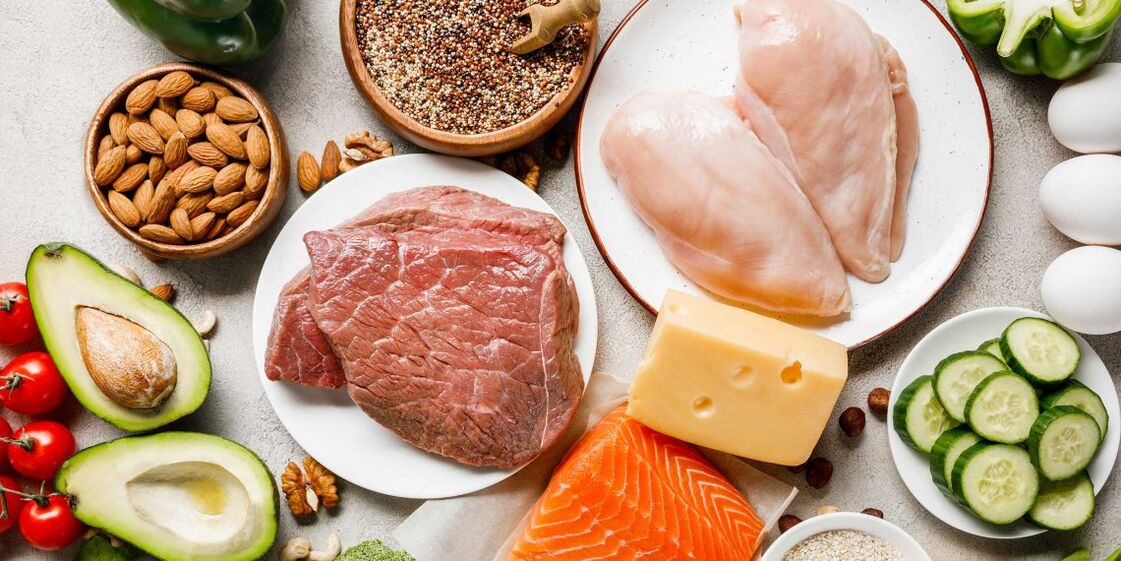On a ketogenic diet, you eat a lot of fatty foods and do not include all flour and sweet. 60-70% of all calories should come from fat, 20-30% protein and only 10% carbohydrates. Special attention is given to carbohydrates: you cannot eat more than 50 g a day, regardless of your weight and calories.

Fat is available from vegetable oil and pork fat, meat and fish, cheese, sour cream, ugly yogurt, eggs, and nuts. Most of these products also contain enough protein to get into the daily rate - 1. 5-2 g per kilogram of weight. You get carbohydrates only from vegetables, fruits and berries without sugar to get enough vitamins. No regular side dishes: cereals, pasta, potatoes. Absolute prohibition of sugar -gula and alcohol.
Because you lose weight on a keto diet
Carbohydrates are the main fuel of the body. When you take less than 50 g of carbohydrates daily, their reserves in the body run out after a day, and the body begins to break down fat and use fatty acids for energy production. However, not all organs can eat fat: the brain only needs glucose or replacement.
To get glucose, the liver makes the body ketone from the fatty acids: the acetate, which then becomes beta-hydroxybutic and nourishes the brain, heart, kidneys, muscles and other tissues. As an exchange product, acetone is formed, so its concentration in the urine increases, and the breathing becomes sweet.
In general, ketones are always produced in the body, their concentration in the blood is about 0. 2-0. 5 mmol/l. When their level grows to 0. 5-5 mmol/l, food ketosis occurs. It is not harmful to health, unlike ketoacidosis, where ketone body concentration increases to 10-25 mmol/l. This condition can occur due to death from hunger.
Although you do not reduce the calorie content of the diet, in the state of ketosis begins to eliminate fat reserves. Because glucose levels in the blood try to zero, the production of hormone insulin is blocked, and thus lipogenesis is a fat deposition in the reserve. In addition, the keto diet reduces your appetite, which also helps you lose weight: you do not consider calories and not break.
How much can be thrown on a ketogenic diet
Everything is an individual here. In a review of six studies dedicated to ketogenic diets, participants lost 3. 2. 2. to 12 kg in six months. If we take the average value for all the results in the review, it will change about 6 kg in 6 months.
Who should try a keto diet
Despite the complexity of the first days and strict restrictions, the ketogenic diet is perfect for some people. It should be trapped:
- Those who love meat. If you can't live without the product and fat, and your diet doesn't care about sugar -gula and bread, your choice.
- Those who want to lose weight without losing muscle mass. Keto diet helps to remove fat, including deep, and at the same time maintains dry muscle mass. Moreover, the diet does not affect the power indicator, so it is suitable for power sports athletes. Although it does not work to improve muscle.
- People with type 1 and 2nd diabetes. Due to failure in insulin production, diabetes patients have to take these hormones to prevent sharp jumps in blood sugar. Keto diet greatly reduces its level. But before moving to Keto, the diet must be referred to the attending physician.
- Those who want to maintain brain health. Keto diet has a positive effect on mental and emotional health, protects the brain from neurodegenerative disease, and helps with migraines and epilepsy.
- Those who want to reduce the risk of atherosclerosis. The diet reduces the "bad" amount of cholesterol and fat in the blood and increases the "good" percentage.
- Those who fear the cancer diet limit the form of reactive oxygen and reduce inflammation, which is often associated with oncology.
- Runners and athletes. If you are a cycle sports athlete for durability, a keto diet can enhance your guidance.

That cannot sit on a ketogenic diet
This diet is contraindicated:
- People with kidney and liver disease, fatty acid oxidation.
- Those involved in team sports, athletes, medium -range runners. If the class involves long accommodation in anaerobic mode, a keto diet will reduce your indicator.
- People with fragile bones. Possible side effects of diet include changes in bone mineral composition, which can lead to increased risk of bone fractures.
Is it difficult to adhere to a ketogenic diet
Keto diet is not the lightest diet, especially at first. When your body begins to develop glucose, the symptoms of keto -Gripp can be clear: nausea, vomiting, headache, fatigue, dizziness, constipation insomnia. They last from 2-3 days to several weeks. In this case, you cannot take more carbohydrates to reduce the situation.
If you break, the body will receive the desired glucose, you will come out of the ketosis and will need to repeat it again. This is the difficulty of maintaining a diet. Instead, this is the advantage: you know that after your breakdown you will need to go through unpleasant adjustments, so you will continue.
How to sit on a keto genetic diet
A personal trainer and nutritionist recommend dividing the period of entry into diets into several phases and adhering to certain rules.
1. Early preparation (2-4 weeks)
Put 40-80 g of coconut oil into the diet to prepare the body with triglycerides. They are quickly absorbed, not stored in fat and processed in the liver in the body of the ketone. Instead of oil, you can take supplements with ketones in the form of powder.
Reduce the amount of carbohydrates to 100 g per day. So you will not go into ketosis, but teach yourself less carbohydrate -rich foods.
2. Entering ketosis (4 days)
Day 1. Skip breakfast and lunch, hunger all day until evening. During dinner, there are no more than 200-300 kcal, 10-15 g of protein and 15-30 g of fat. No carbohydrates.
Day 2. Eat the same portion for breakfast and for lunch, for dinner - ⅔ from your regular food section. No carbohydrates.
Day 3. For breakfast and lunch, you can eat ⅔ from the usual food section, make a full dinner. There is still no carbohydrate.
Day 4. Eat your regular portion, you can turn on the vegetables that are necr -sugar -free and sugar -free fruits.
During this training phase, it is best to replace it with a long walk. This will burn glucose and help incorporate ketosis faster. If you walk around, it seems like your team is on the feet, this is a good sign: the glycogen reserve is almost gone.
Continue taking coconut oil or carbohydrate powder, add vitamins and drinks with electrolytes.
3. Keto adjustment (2-4 weeks)
You need a few weeks to fully adjust to the diet. Currently, you need to support carbohydrates within 30 g a day - if you are involved, and 20 g - if not. Keep in mind that at first the energy level will be slightly lower. This is normal and gradually passed. At this stage, there is no need to take carbohydrate powder anymore.

How much sitting on a keto diet and how to get out so that weight does not return
Keto's genetic diet can last from 3-4 weeks to a year. It doesn't make sense to adhere to the diet for less than three weeks, as at this point your body will pass the adjustment through keto and you will only start getting all the advantages of this diet. For more than a year, there is not enough scientific data to evaluate this, but eating like this all your life is a bad idea. First, prolonged keto diets increase the risk of liver obesity, hypoproteinemia, kidneys and vitamin and mineral deficiency. Second, neglect of one of the macro elements does not affect the life of life in the best way. Data analysis of more than 15 thousand people shows that both advantages and disadvantages of carbohydrates in the long run increase the risk of death. The longest person living in his diet is made up of 50-55%carbohydrates.
GOOD NEWS: It won't be so difficult to hold weight after a diet.
With a conventional diet with a cut of calorie content, the amount of ghrelin-hunger hormone increases, as one wants to eat all the time, break and after ready to throw food. Studies show that with ketogenic these changes do not occur, so it's easier for you to withstand weight. Another study testified that 40 days of diet with a half -year break for the Mediterranean diet led to a stable weight loss without further presence.
The Mediterranean diet is a good choice after keto. It also contains a lot of fat you will use, and carbohydrates are consumed from useful sources: cereal products, vegetables and fruits. Unlike keto diets, Mediterranean can be maintained throughout your life without health risks.















